Phung-Tien Phan
Kartoffel
25 Aug - 12 Nov 2023

Phung-Tien Phan, Hans, 2023, detail view, in: Phung-Tien Phan, Kartoffel, Kunsthalle Basel, 2023, photo: Philipp Hänger / Kunsthalle Basel
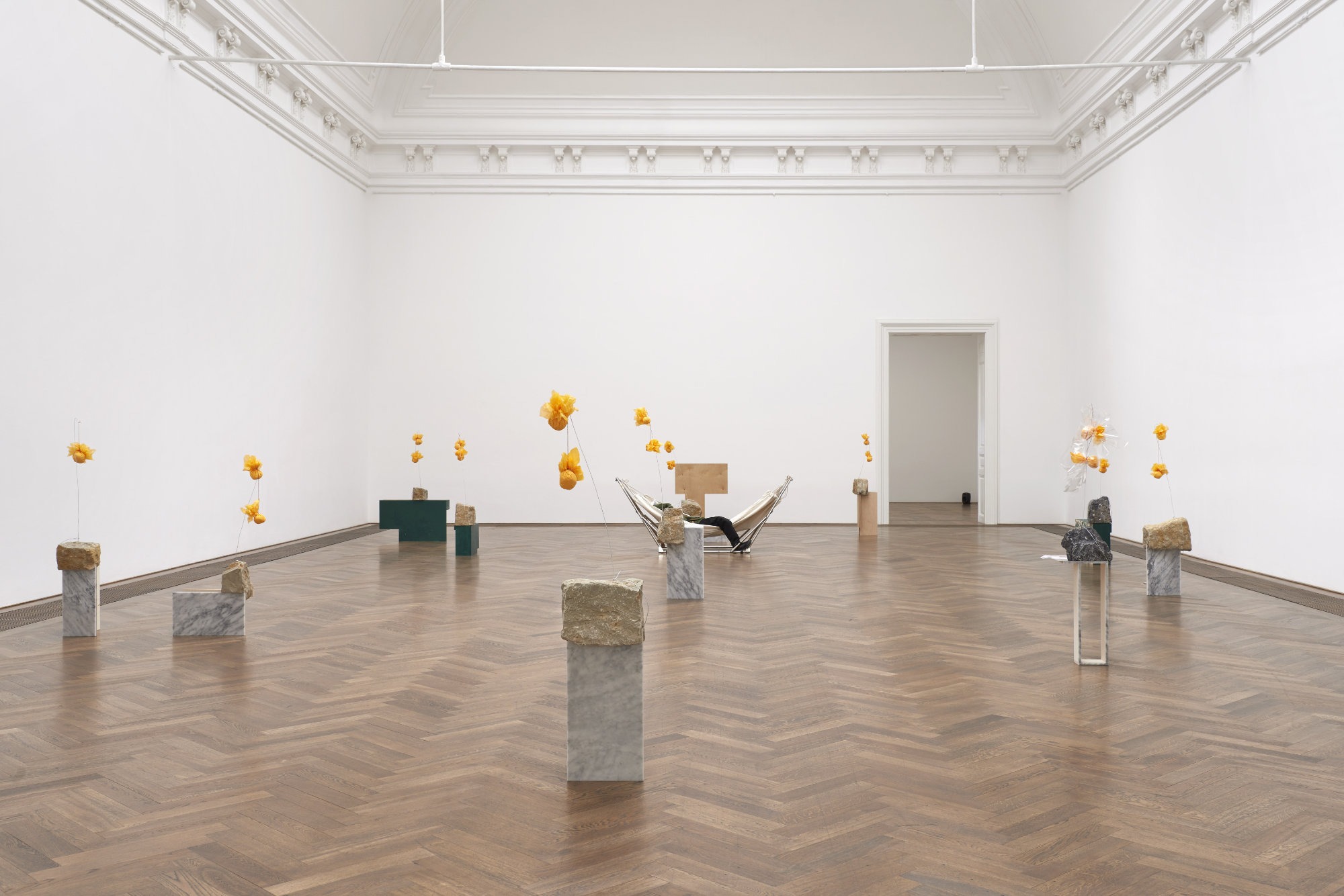
Phung-Tien Phan, Kartoffel, Kunsthalle Basel, 2023, exhibition view, photo: Philipp Hänger / Kunsthalle Basel
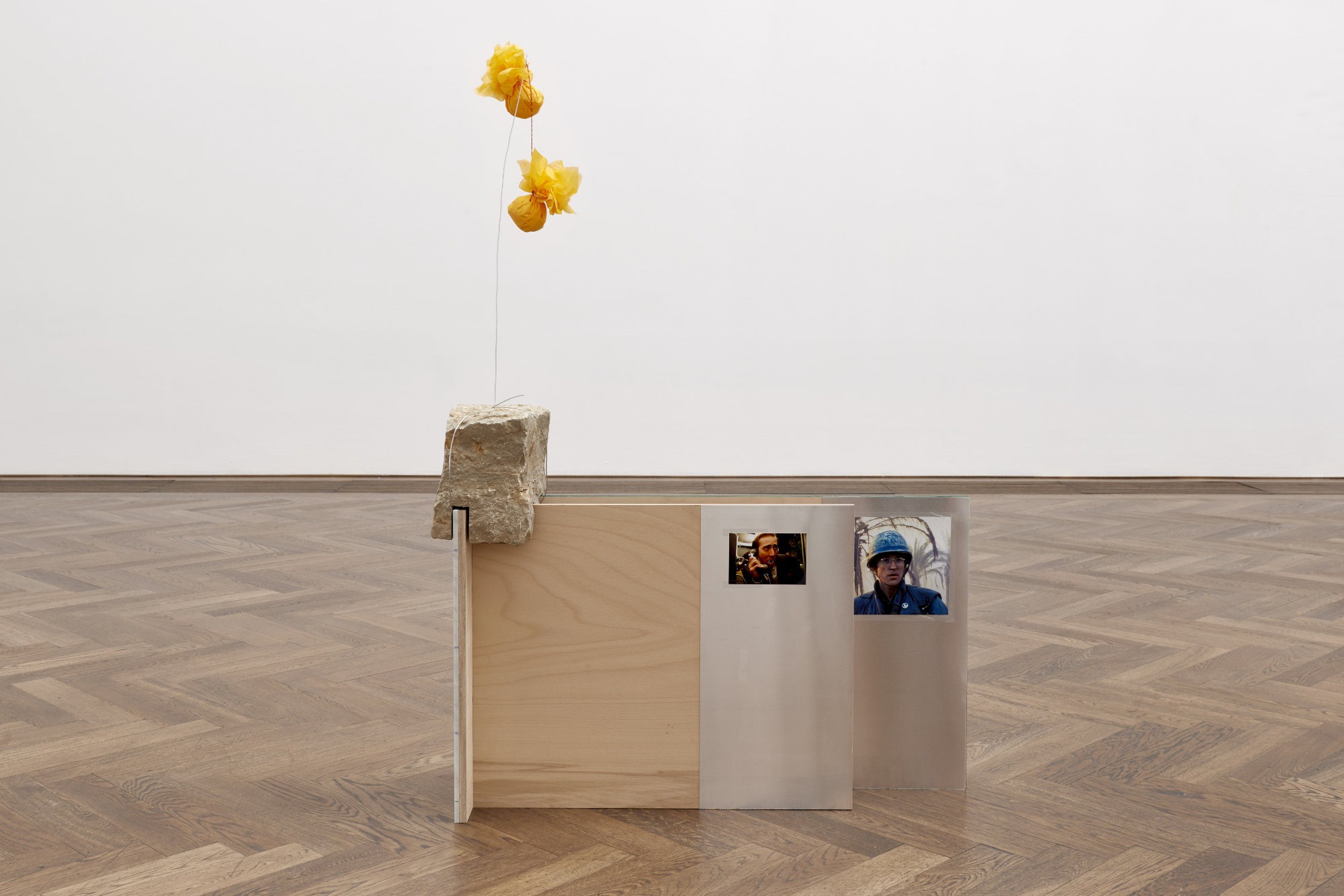
Phung-Tien Phan, Nicolas, 2023, detail view, in: Phung-Tien Phan, Kartoffel, Kunsthalle Basel, 2023, photo: Philipp Hänger / Kunsthalle Basel
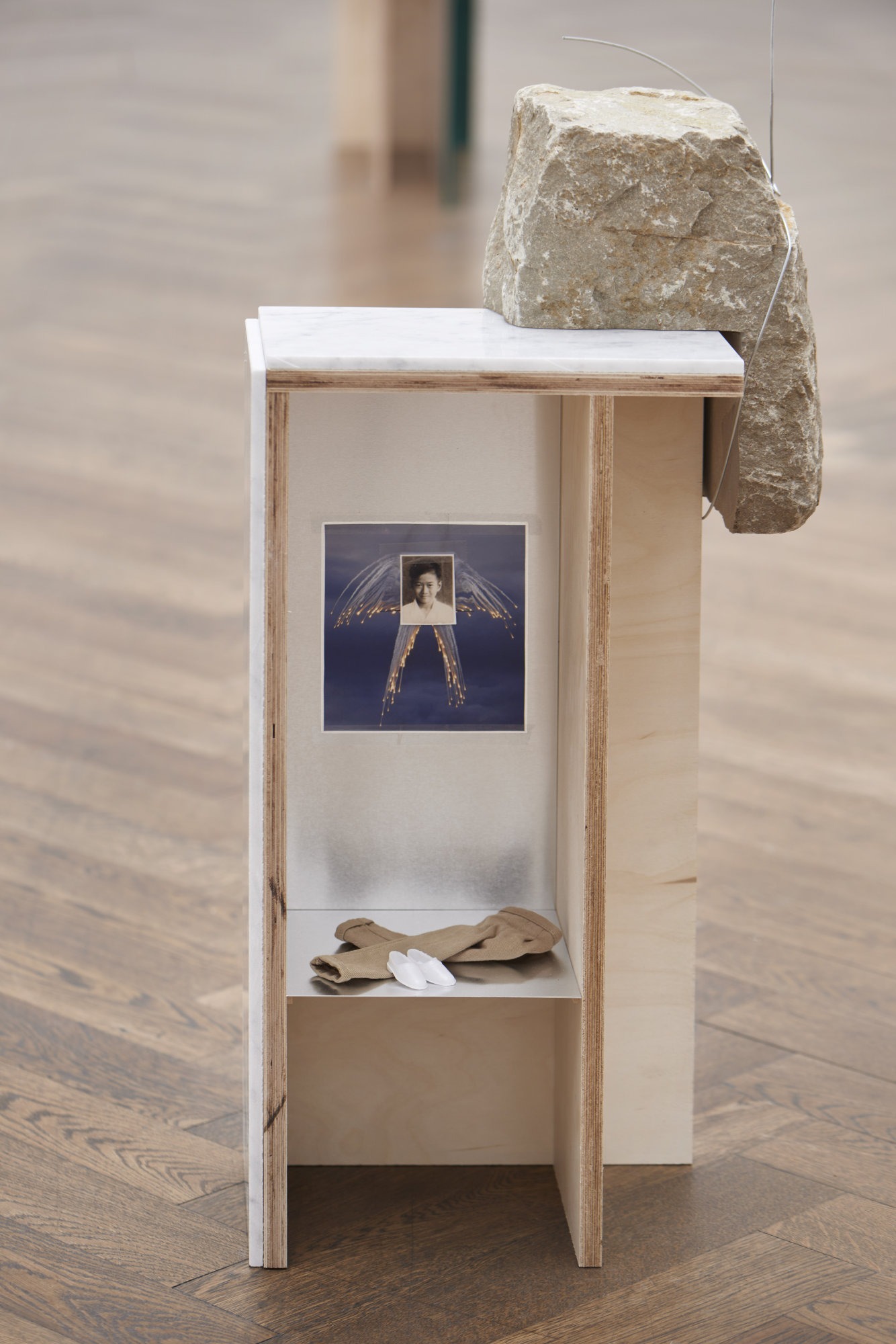
Phung-Tien Phan, Fallen Angels 2, 2023, detail view, in: Phung-Tien Phan, Kartoffel, Kunsthalle Basel, 2023, photo: Philipp Hänger / Kunsthalle Basel
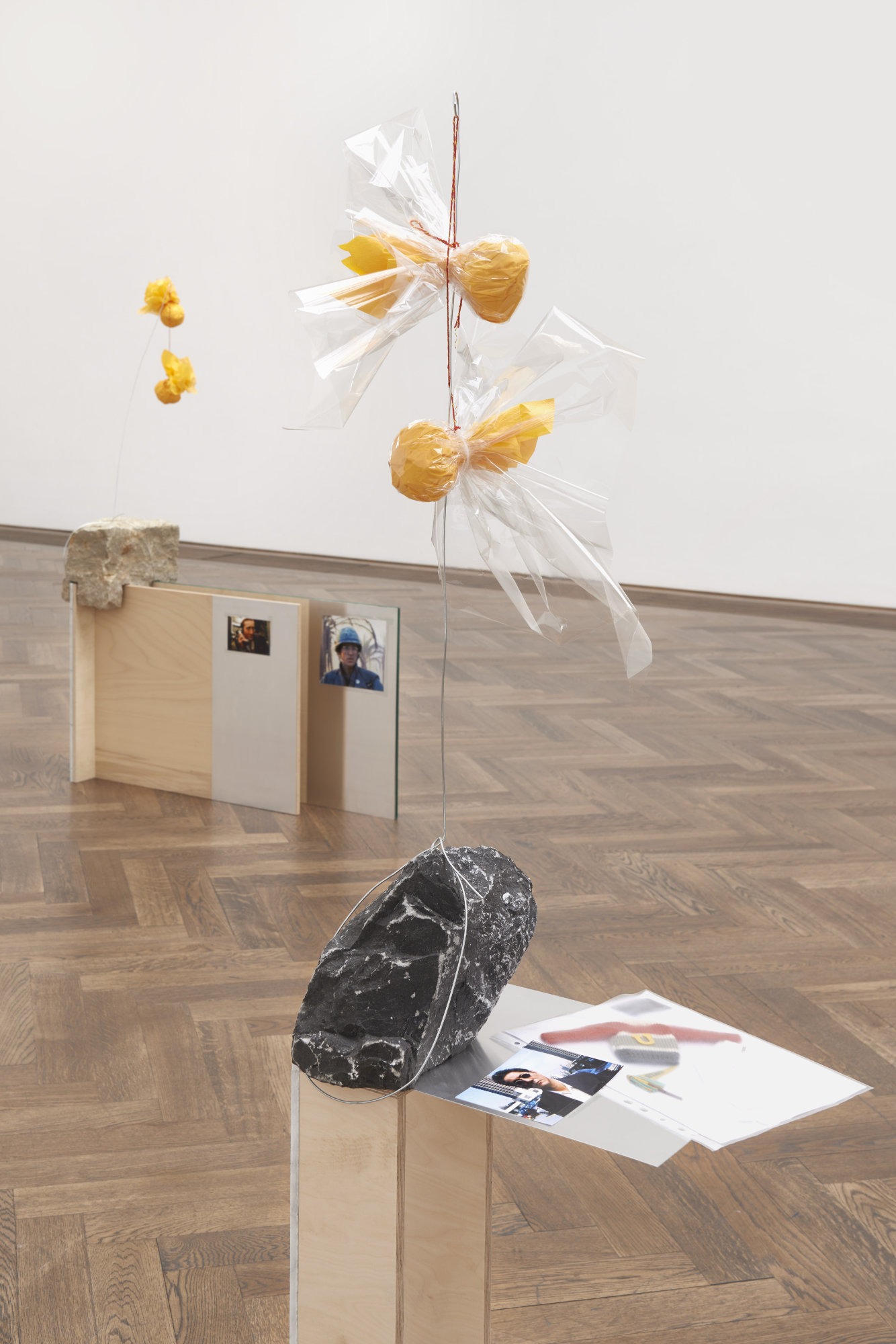
Phung-Tien Phan, front: Takeshi, back: Nicolas, both 2023, installation view, in: Phung-Tien Phan, Kartoffel, Kunsthalle Basel, 2023, photo: Philipp Hänger / Kunsthalle Basel
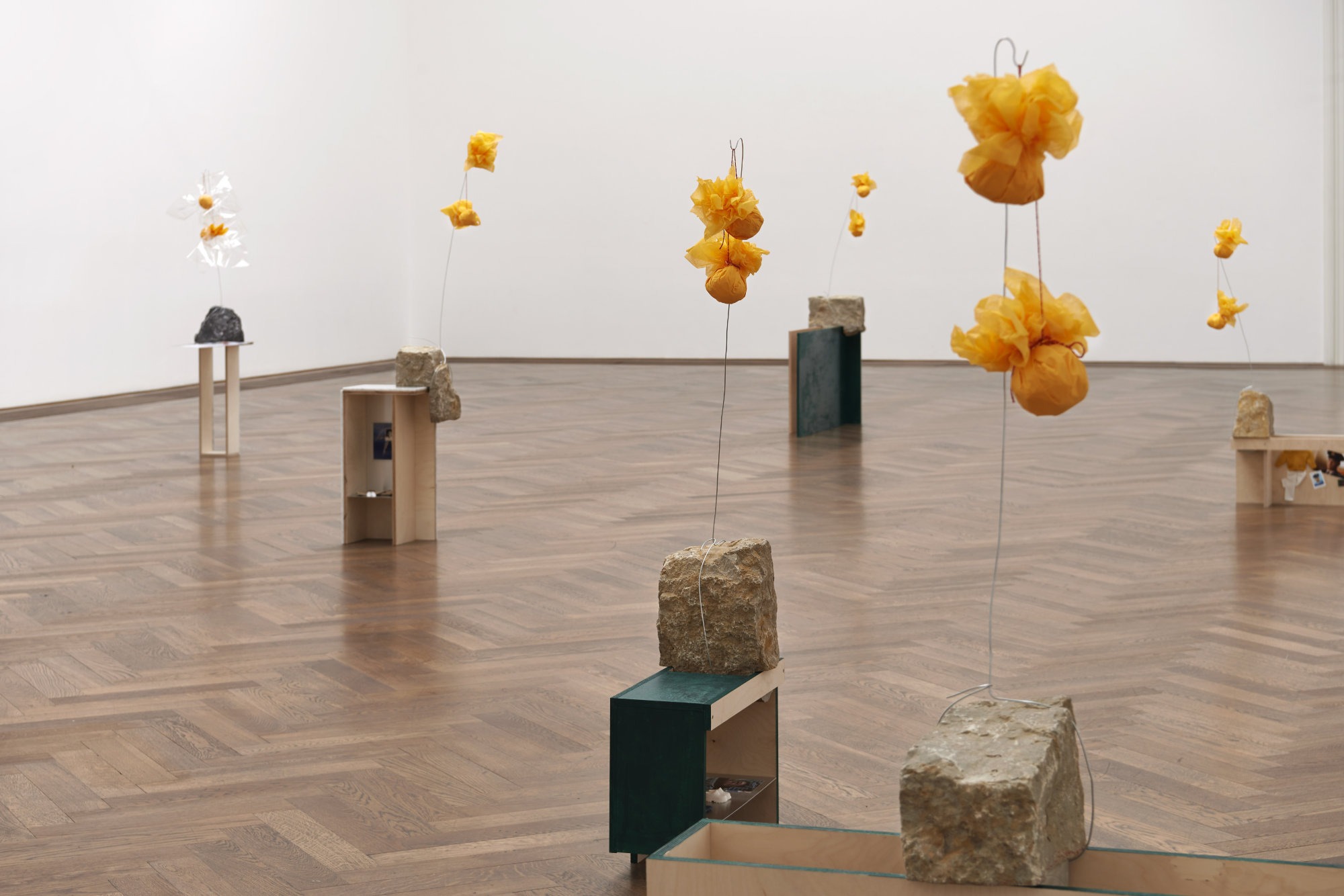
Phung-Tien Phan, Kartoffel, Kunsthalle Basel, 2023, exhibition view, photo: Philipp Hänger / Kunsthalle Basel
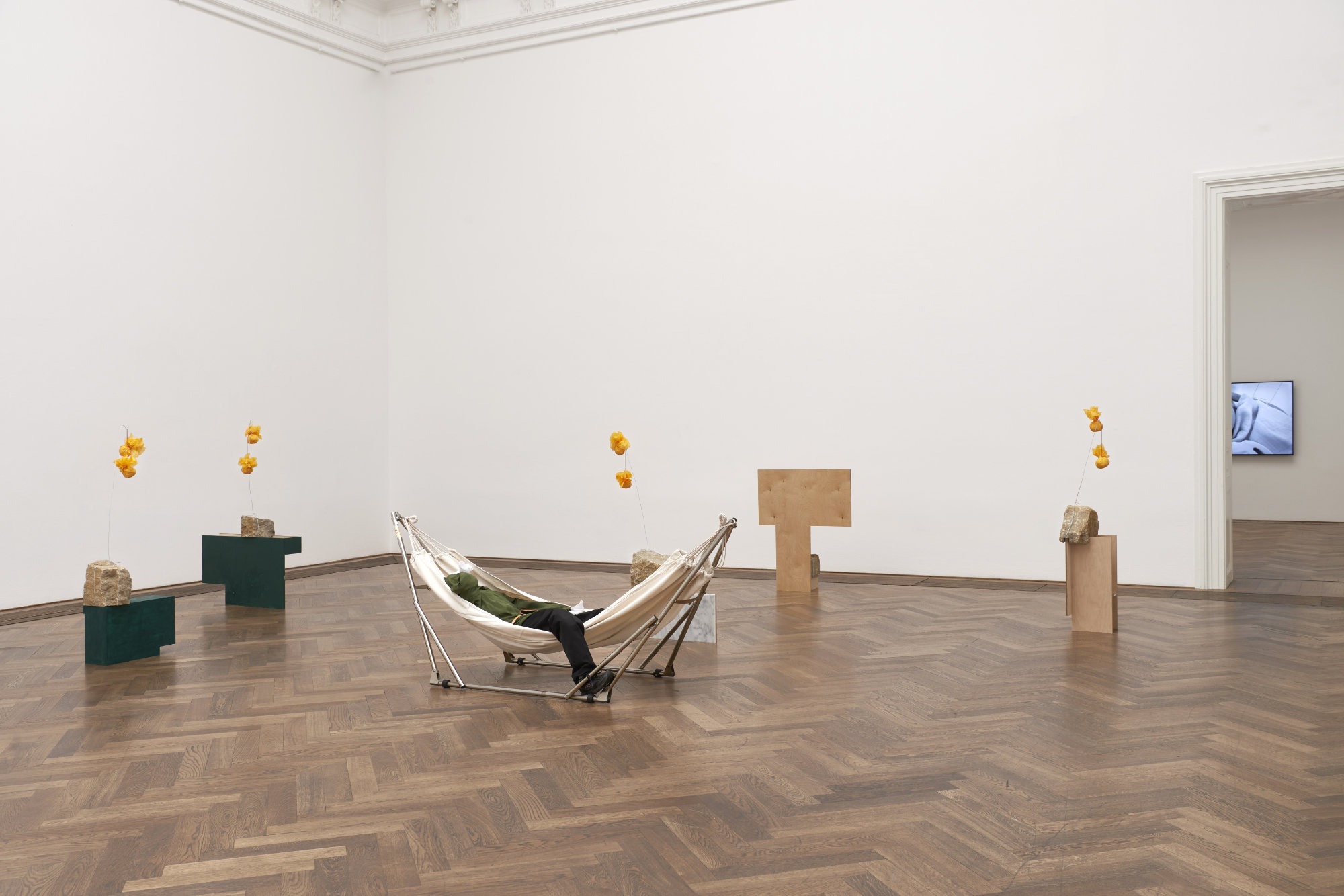
Phung-Tien Phan, Kartoffel, Kunsthalle Basel, 2023, exhibition view, photo: Philipp Hänger / Kunsthalle Basel
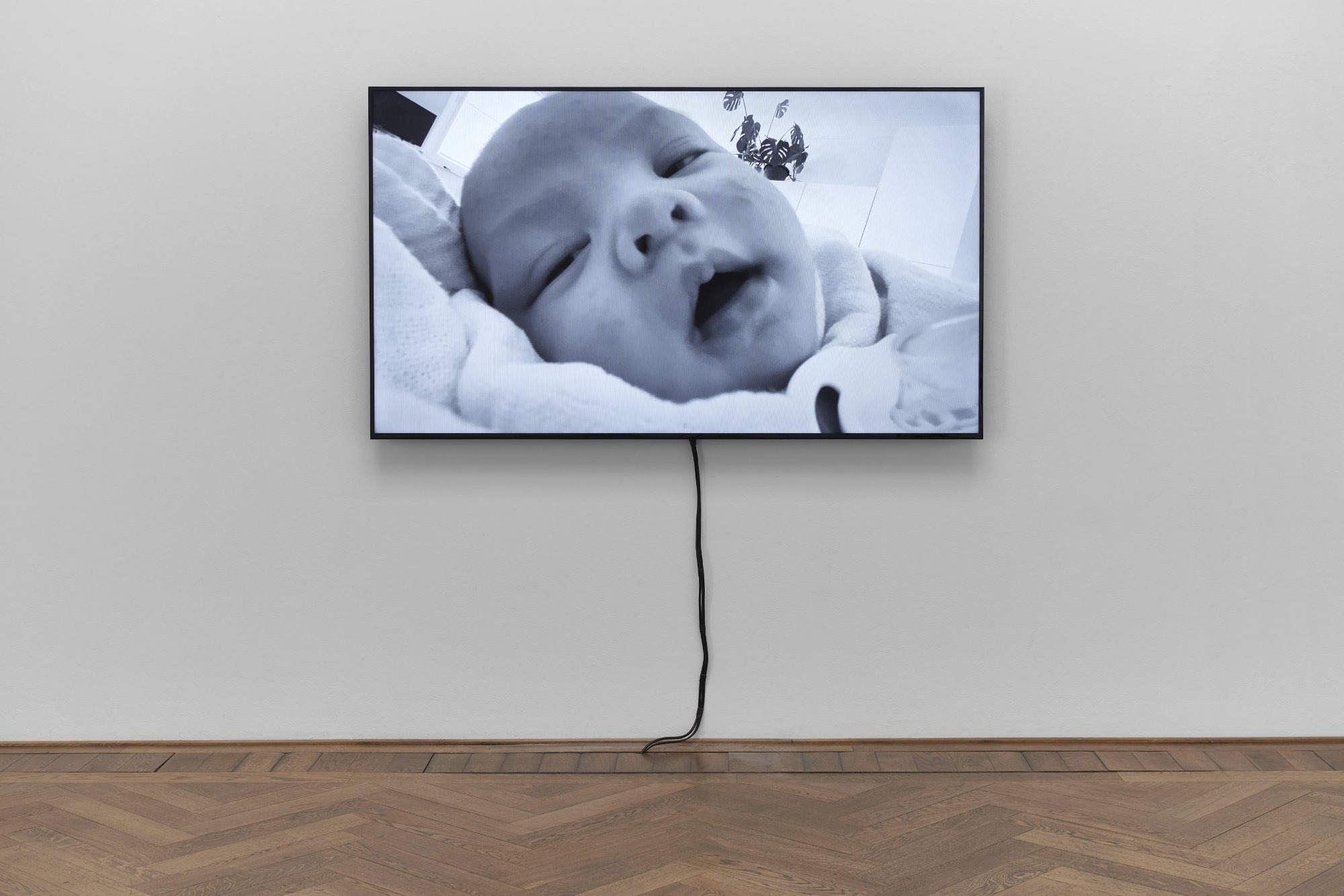
Phung-Tien Phan, Toni 3, 2023, installation view, in: Phung-Tien Phan, Kartoffel, Kunsthalle Basel, 2023, photo: Philipp Hänger / Kunsthalle Basel
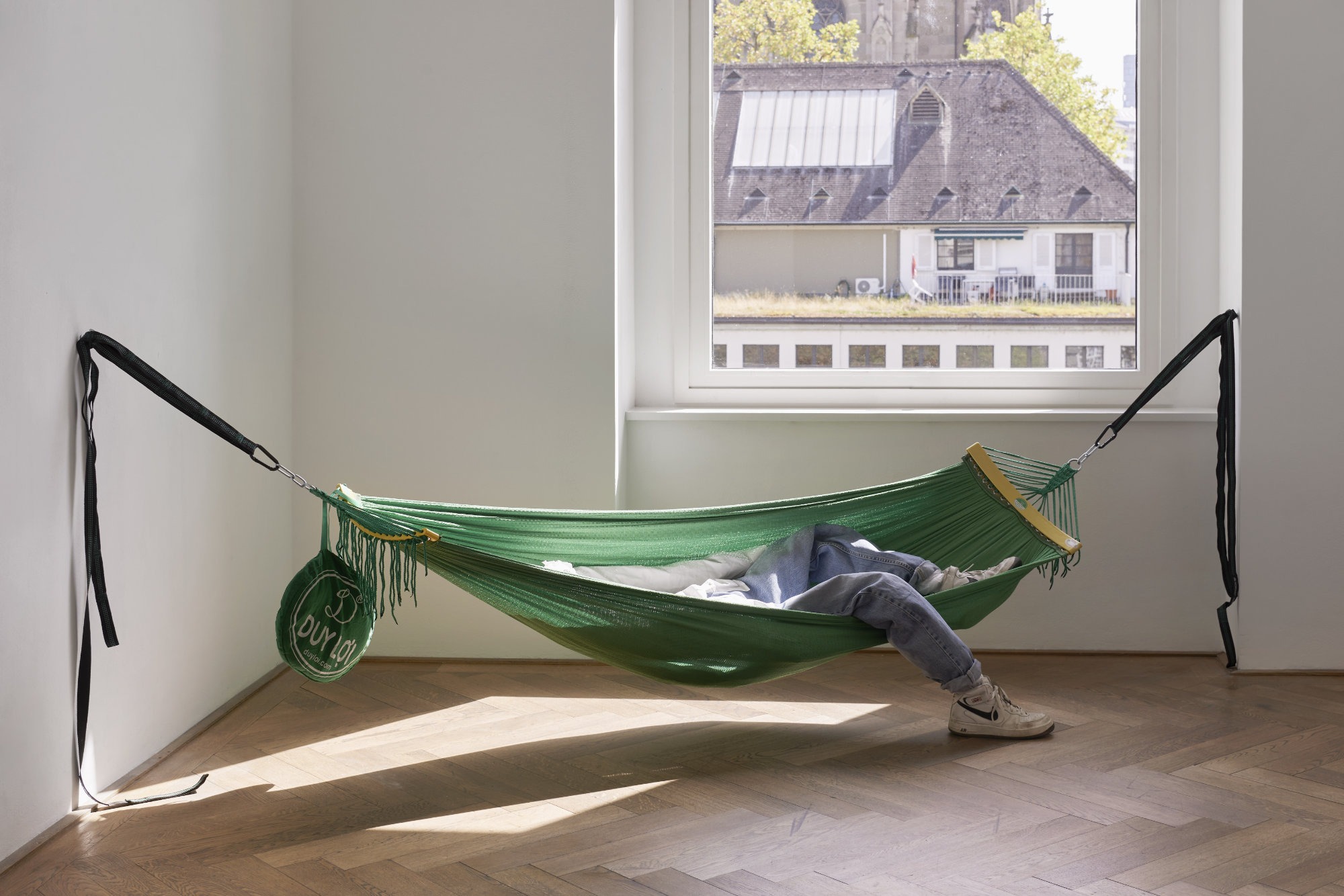
Phung-Tien Phan, Figur 2, 2023, installation view, in: Phung-Tien Phan, Kartoffel, Kunsthalle Basel, 2023, photo: Philipp Hänger / Kunsthalle Basel
A giant applesauce can, feathers, pants, a paper clip, a table, and tape. Or cable ties, cloth cord, doll clothes, paper napkins, and steel wire: these are the stuff of Phung-Tien Phan’s newest body of sculptures. They bear titles such as Charlie, Nicolas, or Takeshi—the first names of men, nearly one and all. Shiny marble slabs topped with rocks and wonky, antenna- like wires conceal (at first view) the interiors of the sculptures’ hollow wooden forms. Like little ad hoc versions of the sorts of Buddhist altars popular among the Asian diaspora, they are replete with occasional shelves and offerings that contain within them clues to their respective titles: in most are nestled doll clothing along with one or more digitally- printed internet-sourced image of a Hollywood actor in one of his seminal movie roles, in one case next to a popular soft drink. The display of these elements is odd: too low to be properly seen without kneeling, but put together with such meticulous attention to the fold in a tiny pair of pants or the angled positioning of mini plastic shoes that one could never mistake it for being offhand. To inspect the items present- ed is to quickly understand that “Charlie” is actor Charlie Sheen, who plays a newly recruited soldier in the 1986 film Platoon, and “George” is actor George Clooney, in the role of a military intelligence lieutenant in the 1997 film The Peacemaker. Performing as either saviors or villains, they embody pop cultural archetypes of heroic masculinity. But do the roles we play determine who we are? How is identity formed anyway, and what forces shape it? Phan quietly unpicks these questions across her exhibition.
Here, as elsewhere in her practice, idiosyncratic combinations of everyday things are placed in precarious balance. Sometimes the elements seem so perilously assembled that a slight push would topple them. Or a component will dangle so casually as if to suggest an after thought. The whole of this young German- Vietnamese artist’s practice is arguably characterized by the dogged pursuit of creating artworks—whether sculpture or video or installation—that refuse preciousness, refuse the slick aura of commodity perfection, and, ultimately, refuse to take themselves too seriously. For all this seeming nonchalance, they tackle weighty themes like diasporic experience, family, identity, or even societal notions of masculine heroism; and more often than not, they do this through the lens of Phan’s biography. What at first may have appeared like afterthoughts, then, are no after- thoughts at all. Precisely these ephemeral elements are what give her art an insouciant allure and its critical thrust. Despite the projected strength, confidence, and resolution of the stock images of her male hero figures, the shrine-like sculptures that Phan has made show them to be little more than rickety, hollow constructs.
But look closely. Among them is one not quite like the others. The pictured reference is not a Hollywood actor; what we see is not a digital printout of a famous face found on the World Wide Web. Instead, one of the sculptures, Fallen Angels 2, contains a black and white pass- port photograph of the artist’s own father as a young boy, taped to a snapshot of a combat jet in flight whose flares are reminiscent of an angel’s wings. Near it, too, a doll’s outfit lies. What kind of hero is a father, an immigrant, a worker, an ordinary extraordinary man? Scattered between the various “hero” sculptures in the exhibition’s main room, one encounters a lone hammock, cradling clothes belonging to the artist herself (obviously full-sized, in this case). Phan lays out her clothes to suggest that the body that would have worn them was lounging, at ease, relaxing amidst this field of sculptures devoted to masculine archetypes.
In the exhibition’s second room, the artist’s newest video, Toni (2023), extends the thematic of the self as an identity under construction. It continues as well the artist’s practice of making lo-fi videos with her hand-held smartphone, recording images of mundane life coupled with tongue-in-cheek, stream-of-conscious monologues. This one begins with the artist vocalizing the sort of guided meditation used in hypnosis that roughly translates from German as: “Relax your legs and loosely place them side by side. Place your hands on your thighs. Breathe deeply, and enter into a trance.” Meanwhile, Phan’s meandering lens takes us from an extreme close-up of the puckered lips and rash- reddened face of her newborn baby boy (the film’s namesake) to domestic spaces, and to family photographs, only to land on the repetitive grid of a ceiling—shot from the baby’s perspective—reminiscent of an airport corridor or public transport underpass. Amongst the family photographs is a handful in which it is un- clear whether you are looking at the artist or her mother or both (in fact, both do make appearances), while the artist narrates a list of the various identities or “types” that might de- scribe them: “Corporate-New-York-Girl,” “Settle-Down-Girl,” “Move-to-France-and- Learn-French-Girl.” One can’t help but wonder: if Toni is the film’s unsuspecting identity-in- the-making, are the various identities of his mother and mother’s mother tangled up in how women traditionally have allowed men to play the “hero”?
The artist positions a hammock in the final room of the exhibition. Here again, laid out in it are the artist’s clothes, stuffed with tissue paper so as to insinuate the body that once in- habited them. It’s such a simple gesture but a weirdly touching one, too: a playful reversal of centuries of figurative sculpture in which materials like stone or plaster convey the body as hardened and whole. It is surrounded by photographic prints, picturing the artist’s father at the funeral of an uncle. One of the images made its first appearance in the video, where already you might have noticed that one man, her father, somehow stands out from the crowd of mourners. He might be amongst family, but he is out of place, although it’s not quite clear why. Is it his clothing or posture? Do “clothes make the man,” as the saying goes?
Phan’s appetite for turning the domestic and ordinary into art makes nearly anything and everything fodder for her practice. Or everything, that is, but the lowly vegetable that gives the exhibition its name. Kartoffel (meaning “potato” in German), Phan’s first solo show in Switzerland, might, on the surface, seem to have nothing to do with potatoes. But one cannot so easily separate the larger questions of identity at the heart of this exhibition from the very specific questions regarding identity experienced by this daughter of Vietnamese immigrant- workers who raised her as a first-generation German-born citizen. “Kartoffel!” The insult (or ironic term of endearment) is meant to refer to Germans that are considered somehow authentically “German.” And no matter that Phan was born in Germany, has a German passport, and has lived there for all her life, her name and appearance make it unlikely that the artist would ever be called Kartoffel. Using the term for her exhibition subtly reminds us that identity is a construct that does not necessarily come from within. Nor can we so easily decide to change it, like a pair of pants you can just put on or take off. Instead, identity is something that others at times confer upon you, whether you like it or not.
Phung-Tien Phan was born in 1983 in Essen, DE; she lives and works in Essen.
Here, as elsewhere in her practice, idiosyncratic combinations of everyday things are placed in precarious balance. Sometimes the elements seem so perilously assembled that a slight push would topple them. Or a component will dangle so casually as if to suggest an after thought. The whole of this young German- Vietnamese artist’s practice is arguably characterized by the dogged pursuit of creating artworks—whether sculpture or video or installation—that refuse preciousness, refuse the slick aura of commodity perfection, and, ultimately, refuse to take themselves too seriously. For all this seeming nonchalance, they tackle weighty themes like diasporic experience, family, identity, or even societal notions of masculine heroism; and more often than not, they do this through the lens of Phan’s biography. What at first may have appeared like afterthoughts, then, are no after- thoughts at all. Precisely these ephemeral elements are what give her art an insouciant allure and its critical thrust. Despite the projected strength, confidence, and resolution of the stock images of her male hero figures, the shrine-like sculptures that Phan has made show them to be little more than rickety, hollow constructs.
But look closely. Among them is one not quite like the others. The pictured reference is not a Hollywood actor; what we see is not a digital printout of a famous face found on the World Wide Web. Instead, one of the sculptures, Fallen Angels 2, contains a black and white pass- port photograph of the artist’s own father as a young boy, taped to a snapshot of a combat jet in flight whose flares are reminiscent of an angel’s wings. Near it, too, a doll’s outfit lies. What kind of hero is a father, an immigrant, a worker, an ordinary extraordinary man? Scattered between the various “hero” sculptures in the exhibition’s main room, one encounters a lone hammock, cradling clothes belonging to the artist herself (obviously full-sized, in this case). Phan lays out her clothes to suggest that the body that would have worn them was lounging, at ease, relaxing amidst this field of sculptures devoted to masculine archetypes.
In the exhibition’s second room, the artist’s newest video, Toni (2023), extends the thematic of the self as an identity under construction. It continues as well the artist’s practice of making lo-fi videos with her hand-held smartphone, recording images of mundane life coupled with tongue-in-cheek, stream-of-conscious monologues. This one begins with the artist vocalizing the sort of guided meditation used in hypnosis that roughly translates from German as: “Relax your legs and loosely place them side by side. Place your hands on your thighs. Breathe deeply, and enter into a trance.” Meanwhile, Phan’s meandering lens takes us from an extreme close-up of the puckered lips and rash- reddened face of her newborn baby boy (the film’s namesake) to domestic spaces, and to family photographs, only to land on the repetitive grid of a ceiling—shot from the baby’s perspective—reminiscent of an airport corridor or public transport underpass. Amongst the family photographs is a handful in which it is un- clear whether you are looking at the artist or her mother or both (in fact, both do make appearances), while the artist narrates a list of the various identities or “types” that might de- scribe them: “Corporate-New-York-Girl,” “Settle-Down-Girl,” “Move-to-France-and- Learn-French-Girl.” One can’t help but wonder: if Toni is the film’s unsuspecting identity-in- the-making, are the various identities of his mother and mother’s mother tangled up in how women traditionally have allowed men to play the “hero”?
The artist positions a hammock in the final room of the exhibition. Here again, laid out in it are the artist’s clothes, stuffed with tissue paper so as to insinuate the body that once in- habited them. It’s such a simple gesture but a weirdly touching one, too: a playful reversal of centuries of figurative sculpture in which materials like stone or plaster convey the body as hardened and whole. It is surrounded by photographic prints, picturing the artist’s father at the funeral of an uncle. One of the images made its first appearance in the video, where already you might have noticed that one man, her father, somehow stands out from the crowd of mourners. He might be amongst family, but he is out of place, although it’s not quite clear why. Is it his clothing or posture? Do “clothes make the man,” as the saying goes?
Phan’s appetite for turning the domestic and ordinary into art makes nearly anything and everything fodder for her practice. Or everything, that is, but the lowly vegetable that gives the exhibition its name. Kartoffel (meaning “potato” in German), Phan’s first solo show in Switzerland, might, on the surface, seem to have nothing to do with potatoes. But one cannot so easily separate the larger questions of identity at the heart of this exhibition from the very specific questions regarding identity experienced by this daughter of Vietnamese immigrant- workers who raised her as a first-generation German-born citizen. “Kartoffel!” The insult (or ironic term of endearment) is meant to refer to Germans that are considered somehow authentically “German.” And no matter that Phan was born in Germany, has a German passport, and has lived there for all her life, her name and appearance make it unlikely that the artist would ever be called Kartoffel. Using the term for her exhibition subtly reminds us that identity is a construct that does not necessarily come from within. Nor can we so easily decide to change it, like a pair of pants you can just put on or take off. Instead, identity is something that others at times confer upon you, whether you like it or not.
Phung-Tien Phan was born in 1983 in Essen, DE; she lives and works in Essen.
